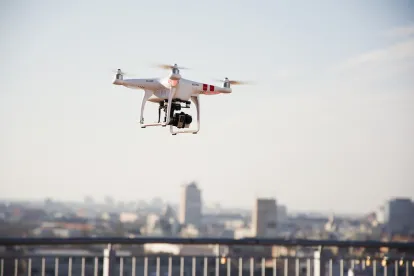Once thought of as weapons of war, commercial use of drones is now on the rise, with companies like Amazon jostling to position themselves at the forefront of the market (launching futuristic initiatives such as Prime Air and filing patent applications for inventions like flying warehouses). In the medical industry, drones have been trialled for the delivery of blood and medicines to remote areas, including in Rwanda and the US. But what, if anything, might drones bring to the sports industry? Do they have more to offer than the – admittedly appealing but arguably impractical (at least from a safety point of view) – idea of having a beer delivered to you in your seat at the stadium?
Whilst many wrote off the ‘flying bar’ concept as a gimmick, it was a very real venture and its refusal by the US Federal Aviation Administration is a good example of the current confines around the expansion of commercial drone use. The challenge is to capitalise on the commercial and technological potential of drones whilst navigating a complex and developing area of law.
In the UK, the regulatory regime is comparatively flexible, though the Civil Aviation Authority imposes certain key restrictions, which differ depending on the drone size/weight (generally measured in ‘Maximum Take Off Mass’) and the location in which they are being operated (the general position unsurprisingly being that the more built-up the area, the more stringent the requirements). Importantly, pursuant to Articles 94 and 95 of the Air Navigation Order 2016, permission from the CAA is required for any organisation or individual wishing to:
-
fly a drone during commercial operations; and/or
-
fly a camera-fitted drone within congested areas or within specified distances of people or certain properties (vehicles, vessels or structures).
OfCom also regulates the use of certain frequencies, which can present technological difficulties for certain drone-based operations.
Operators will also need to consider the privacy and data protection implications of their drone operations (particularly in densely populated areas), as well as their insurance and liability exposure, as EU legislation imposes minimum requirements and the principle of strict liability generally applies in relation to damage to persons or property caused by drones.
Enhancing the sports industry?
The legal framework therefore presents a raft of considerations for any organisation wishing to augment its business through the use of drones. In the sports industry, the wide potential of drones has already started to emerge in a number of fields:
-
Broadcasting: given the flexibility and speed of drones, and the increasingly impressive on-board camera technology (including image stabilising) there is increasing potential for drones to replace and add to some of the functionalities of wired stadium camera systems like SkyCam, offering a multitude of angles and heights that wired cameras simply cannot. These are functionalities that some broadcasters are already starting to develop. The potential to make water-based sports like surfing or rowing more accessible to broadcasters has been hailed by some as a ‘game-changer’. There may even be potential for drones to assume referee functionalities (think TMO in the sky).
-
Training: again, due to the unique viewpoints drones can offer, the potential for use as a training tool is enormous. Indeed a number of Premier League and Championship football clubs are already utilising them in training, including compiling individualised databases of video-clips for each player.
-
Security: drones also have the potential to assist with security operations and surveillance, an increasingly important consideration for event owners and organisers in the current climate, and something that was seen at Euro 2016.
-
In-event logistics: whilst the flying bar concept may remain impractical within a crowded stadium, the use of drones to assist with the logistics aspects of an event (for example, to move stock around) still carries potential. This might see drones operating along fixed routes or stadium perimeters to deliver stock where it is needed most and respond to crowds.
A sport in its own right?
In addition to the potential to enhance the experience of athletes, consumers and other stakeholders in the sports industry, drones are emerging as a sporting activity in their own right.
Borne out of some the most advances in drone and virtual reality technology, drone racing has now become a reality. Using drones’ on-board camera technology and virtual reality goggles, pilots can fly remotely in ‘first person view’ (“FPV”) from a virtual cockpit. This has led to establishment of competitive leagues, such as the Drone Racing League (“DRL”) (the global leader in FPV racing), which has already attracted major sponsors, with the 2017 Allianz World Championships (featuring the world’s top 16 pilots over a 6-race series) set to be broadcast on Sky, ESPN, and Prosieban MAXX.
According to a PwC report, drone racing is expected to grow in a similar way to eSports, with a key appeal factor for spectators being the endless range of settings in which competitive drone racing can be held, in addition to its potential a live stadium sport, races can occur. For example, DRL races have been held in an abandoned New York power station, a Hollywood shopping mall, and NFL’s Sun Life Stadium.
As Sports Shorts has covered previously, eSports have often been the subject of criticism due to the absence of physical athletic skill. As well as representing a merging of the real and virtual worlds, drone racing appears to sit somewhere in the middle of traditional sport and concepts like eSports. The skill required is arguably not dissimilar from that of professional gamers, yet in this case the action takes place in real life.
The future
Notwithstanding the numerous legal considerations, and the differing levels of regulatory restriction across different jurisdictions, it is clear that drones offer huge commercial potential, both as a tool within sports generally and as a sport in their own right. The current uses of drones within sport is likely to be merely the tip of the iceberg.



 />i
/>i

